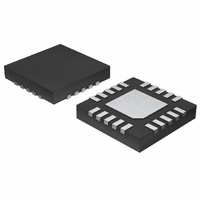MAX1980ETP+T Maxim Integrated Products, MAX1980ETP+T Datasheet - Page 12

MAX1980ETP+T
Manufacturer Part Number
MAX1980ETP+T
Description
IC CNTRLR QUICK-PWM 20-TQFN
Manufacturer
Maxim Integrated Products
Datasheet
1.MAX1980ETPT.pdf
(33 pages)
Specifications of MAX1980ETP+T
Pwm Type
Controller
Number Of Outputs
1
Frequency - Max
550kHz
Duty Cycle
50%
Voltage - Supply
4 V ~ 28 V
Buck
Yes
Boost
No
Flyback
No
Inverting
No
Doubler
No
Divider
No
Cuk
No
Isolated
No
Operating Temperature
0°C ~ 85°C
Package / Case
20-TQFN Exposed Pad
Frequency-max
550kHz
Input Voltage
4 V to 28 V
Mounting Style
SMD/SMT
Maximum Operating Temperature
+ 100 C
Minimum Operating Temperature
- 40 C
Lead Free Status / RoHS Status
Lead free / RoHS Compliant
Quick-PWM Slave Controller with
Driver Disable for Multiphase DC-DC Converter
The trigger input’s polarity is selected by connecting
POL to V
At the slave controller’s core is the one-shot that sets
the high-side switch’s on-time. This fast, low-jitter one-
shot adjusts the on-time in response to the input volt-
age and the difference between the inductor currents in
the master and the slave. Two identical transconduc-
tance amplifiers (G
between the master and slave current-sense signals.
The summed output is connected to COMP, allowing
adjustment of the integration time constant with a com-
pensation capacitor connected at COMP. The resulting
compensation current and voltage may be determined
by the following equations:
where Z
The PWM controller uses this integrated signal (V
to set the slave controller’s on time. When the master
and slave current-sense signals (CM+ to CM- and CS+
to CS-) become unbalanced, the transconductance
amplifiers adjust the slave controller’s on time, allowing
the slave inductor current to increase or decrease until
the current-sense signals are properly balanced:
12
Table 2. Component Suppliers
MOSFETS
Fairchild Semiconductor
International Rectifier
Siliconix
CAPACITORS
Kemet
Panasonic
Sanyo
Taiyo Yuden
INDUCTORS
Coilcraft
Coiltronics
Sumida
I
V
______________________________________________________________________________________
COMP
COMP
COMP
CC
MANUFACTURER
=
=
(rising edge) or to GND (falling edge).
G
V
MM
OUT
is the impedance at the COMP output.
(
V
+
CM
MM
I
COMP COMP
+
-
= G
V
Z
CM
MS
-
)
) integrate the difference
-
G
MS
(
V
CS
+
-
V
CS
65-281-3226 (Singapore)
-
03-3667-3408 (Japan)
)
COUNTRY CODE
COMP
1-888-522-5372
1-310-322-3331
1-203-268-6261
1-408-986-0424
1-847-468-5624
1-408-749-9714
1-408-573-4150
1-800-322-2645
1-561-752-5000
1-408-982-9660
PHONE
)
This control algorithm results in balanced inductor cur-
rents with the slave switching frequency synchronized to
the master. Since the master operates at nearly constant
frequency, the slave will as well. The benefits of a con-
stant switching frequency are twofold: first, the frequency
can be selected to avoid noise-sensitive regions of the
spectrum; second, the inductor ripple-current operating
point remains relatively constant, resulting in easy design
methodology and predictable output-voltage ripple.
Multiple phase switching effectively distributes the load
among the external components, thereby improving the
overall efficiency. Distributing the load current between
multiple phases lowers the peak inductor current by the
number of phases (1/
phase converter. This significantly reduces the I
across the inductor’s series resistance, the MOSFETs
on-resistance, and the board resistance.
t
ON
=
=
= (Master’s on time) + (Slave’s on-time
K
K
correction due to current imbalance)
www.fairchildsemi.com
www.irf.com
www.vishay.com
www.kemet.com
www.panasonic.com
www.secc.co.jp
www.t-yuden.com
www.coilcraft.com
www.coiltronics.com
www.sumida.com
V
V
COMP
OUT
V
V
IN
η
IN
) when compared to a single-
+
K
WEBSITE
I
COMP C
V
IN
Z
2
R losses











